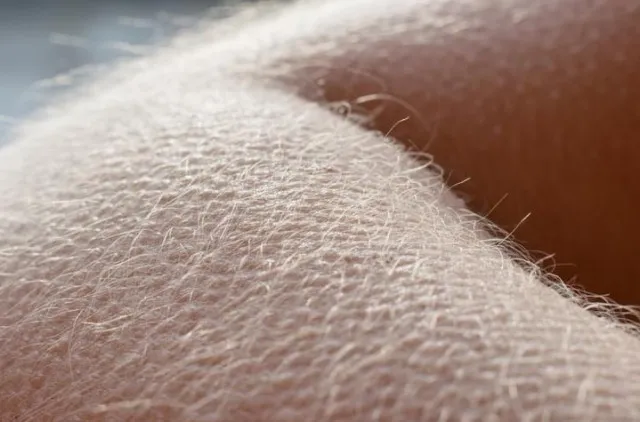Ever felt chills crawl up your spine when a powerful song plays, a movie stirs your soul, or nostalgia sweeps over you? Those tiny bumps that appear on your skin, commonly known as goosebumps, are more than just a physical response—they’re a glimpse into the profound connection between your emotions and biology. But what exactly triggers this reaction, and why does it happen? Let’s delve into the fascinating science behind goosebumps and their link to strong emotions.
What Are Goosebumps?

Goosebumps, or piloerection, occur when tiny muscles at the base of your hair follicles contract, causing your hair to stand on end. This creates the distinct bumpy texture on your skin.
This reflex isn’t just random—it’s an evolutionary leftover from our ancestors. For animals with thick fur, this reaction helped them appear larger to predators or retain warmth by trapping an insulating layer of air. Though modern humans don’t rely on body hair for these purposes, the reflex still persists, often triggered by emotions, cold temperatures, or sudden sensations.
The Evolutionary Roots of Goosebumps
Goosebumps are deeply tied to the fight-or-flight response, which prepares the body to react to danger. When faced with a perceived threat, your brain releases adrenaline, setting off a series of physical responses—including goosebumps.
For our ancestors, this was a survival mechanism:
- Protection Against Cold: Raised hair created a layer of insulation, helping to retain body heat.
- Defense Against Predators: Making their fur stand on end made animals appear larger and more intimidating.
Even though humans don’t rely on fur for survival anymore, the reflex remains an automatic response to emotional or environmental stimuli.
Why Do Goosebumps Happen When You’re Emotional?
Strong emotions, such as fear, joy, or awe, can trigger the same adrenaline release that cold temperatures do. This is why you might experience goosebumps during an intense movie scene, a heartwarming moment, or an exhilarating event. Here’s how it works:
- Fear and Suspense
When you’re startled or scared, your brain perceives a potential threat. This activates the fight-or-flight system, causing adrenaline to surge and goosebumps to appear. - Excitement and Thrill
Experiencing a thrilling moment—like watching your favorite team score a game-winning goal—can also trigger an adrenaline rush, sparking goosebumps. - Awe and Inspiration
Uplifting moments, such as listening to a powerful speech or witnessing a stunning view, can evoke goosebumps as your body physically reacts to the emotional impact. - Sadness or Nostalgia
Reflecting on a poignant memory or watching a touching scene can activate the same biological response, leading to those familiar chills.
The Role of Adrenaline in Goosebumps

Adrenaline is the star player in this phenomenon. Released by the adrenal glands during moments of heightened emotion, it prepares your body to react quickly to a situation. Goosebumps are just one of the many physical effects of this hormone, alongside an increased heart rate, rapid breathing, and heightened alertness.
While adrenaline’s primary purpose is survival, it also enhances our emotional experiences, making those moments more memorable and impactful.
Other Surprising Triggers of Goosebumps
Beyond strong emotions and cold, several other factors can cause goosebumps. These include:
- Sudden Physical Sensations
A chill down your spine or a breeze brushing your skin can stimulate the reflex. - Memories and Nostalgia
Hearing a song that transports you back to a vivid memory or reliving a meaningful experience can evoke goosebumps. - Temperature Changes
Walking into a cold room or feeling a sudden drop in temperature can prompt the reaction, even if you’re not emotionally moved.
Why Some People Get Goosebumps More Often

Not everyone experiences goosebumps the same way. Your sensitivity to emotional or physical triggers can vary based on several factors:
- Genetics
Your DNA influences how your body reacts to stimuli, including the likelihood of getting goosebumps. - Emotional Sensitivity
People who are more empathetic or emotionally expressive tend to experience goosebumps more frequently. - Personal Associations
Specific memories or experiences tied to certain stimuli can heighten your body’s response. For instance, a song that played during a significant life event may elicit a stronger reaction.
Cultural and Social Significance of Goosebumps
Goosebumps aren’t just a biological quirk—they’re a shared human experience. Across cultures, they’re often associated with deeply moving moments, whether it’s a soul-stirring performance, a heartfelt reunion, or an awe-inspiring view. This universal reaction connects us, signaling that we’ve been profoundly touched by something.
The Connection Between Goosebumps and Music

Music is one of the most common triggers for goosebumps. Researchers have found that certain songs or melodies can activate the brain’s reward system, releasing dopamine and creating a physical reaction. This is why some people describe getting “chills” during particularly moving musical moments.
Understanding Goosebumps as a Reflection of Emotional Depth
Goosebumps are more than a skin-deep reaction—they’re a testament to the profound connection between our bodies and minds. They signal moments that move us, reminding us of our shared humanity and the power of emotion.
Conclusion
Goosebumps are an incredible example of how intertwined our emotions and biology are. Whether sparked by a breathtaking view, a nostalgic memory, or a thrilling moment, these tiny bumps are a window into our evolutionary past and emotional depth. The next time you feel chills creeping up your arms, pause and appreciate the magic of this response—it’s your body’s way of showing just how deeply a moment resonates with you. Isn’t it amazing how something so small can carry such profound meaning?


